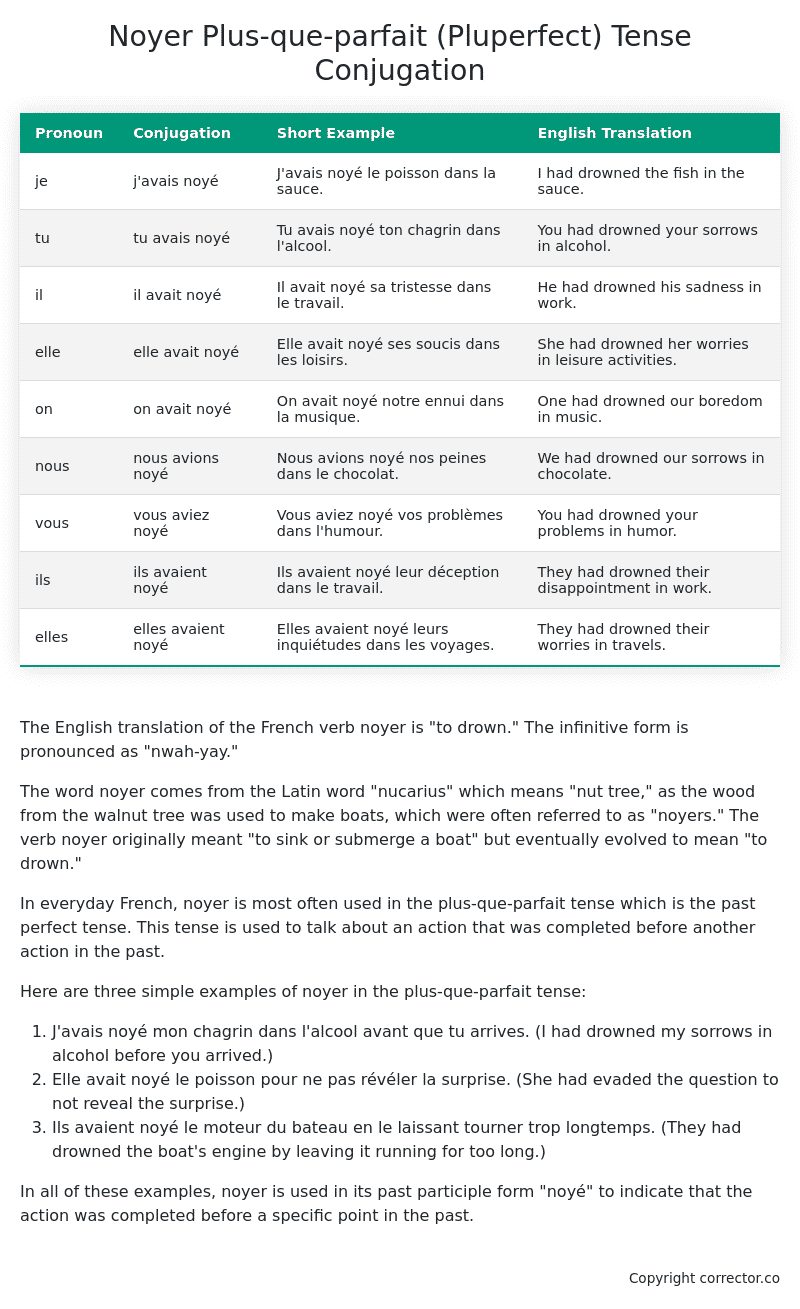Plus-que-parfait (Pluperfect) Tense Conjugation of the French Verb noyer
Introduction to the verb noyer
The English translation of the French verb noyer is “to drown.” The infinitive form is pronounced as “nwah-yay.”
The word noyer comes from the Latin word “nucarius” which means “nut tree,” as the wood from the walnut tree was used to make boats, which were often referred to as “noyers.” The verb noyer originally meant “to sink or submerge a boat” but eventually evolved to mean “to drown.”
In everyday French, noyer is most often used in the plus-que-parfait tense which is the past perfect tense. This tense is used to talk about an action that was completed before another action in the past.
Here are three simple examples of noyer in the plus-que-parfait tense:
- J’avais noyé mon chagrin dans l’alcool avant que tu arrives. (I had drowned my sorrows in alcohol before you arrived.)
- Elle avait noyé le poisson pour ne pas révéler la surprise. (She had evaded the question to not reveal the surprise.)
- Ils avaient noyé le moteur du bateau en le laissant tourner trop longtemps. (They had drowned the boat’s engine by leaving it running for too long.)
In all of these examples, noyer is used in its past participle form “noyé” to indicate that the action was completed before a specific point in the past.
Table of the Plus-que-parfait (Pluperfect) Tense Conjugation of noyer
| Pronoun | Conjugation | Short Example | English Translation |
|---|---|---|---|
| je | j’avais noyé | J’avais noyé le poisson dans la sauce. | I had drowned the fish in the sauce. |
| tu | tu avais noyé | Tu avais noyé ton chagrin dans l’alcool. | You had drowned your sorrows in alcohol. |
| il | il avait noyé | Il avait noyé sa tristesse dans le travail. | He had drowned his sadness in work. |
| elle | elle avait noyé | Elle avait noyé ses soucis dans les loisirs. | She had drowned her worries in leisure activities. |
| on | on avait noyé | On avait noyé notre ennui dans la musique. | One had drowned our boredom in music. |
| nous | nous avions noyé | Nous avions noyé nos peines dans le chocolat. | We had drowned our sorrows in chocolate. |
| vous | vous aviez noyé | Vous aviez noyé vos problèmes dans l’humour. | You had drowned your problems in humor. |
| ils | ils avaient noyé | Ils avaient noyé leur déception dans le travail. | They had drowned their disappointment in work. |
| elles | elles avaient noyé | Elles avaient noyé leurs inquiétudes dans les voyages. | They had drowned their worries in travels. |
Other Conjugations for Noyer.
Le Present (Present Tense) Conjugation of the French Verb noyer
Imparfait (Imperfect) Tense Conjugation of the French Verb noyer
Passé Simple (Simple Past) Tense Conjugation of the French Verb noyer
Passé Composé (Present Perfect) Tense Conjugation of the French Verb noyer
Futur Simple (Simple Future) Tense Conjugation of the French Verb noyer
Futur Proche (Near Future) Tense Conjugation of the French Verb noyer
Plus-que-parfait (Pluperfect) Tense Conjugation of the French Verb noyer (this article)
Passé Antérieur (Past Anterior) Tense Conjugation of the French Verb noyer
Futur Antérieur (Future Anterior) Tense Conjugation of the French Verb noyer
Subjonctif Présent (Subjunctive Present) Tense Conjugation of the French Verb noyer
Subjonctif Passé (Subjunctive Past) Tense Conjugation of the French Verb noyer
Subjonctif Imparfait (Subjunctive Imperfect) Tense Conjugation of the French Verb noyer
Subjonctif Plus-que-parfait (Subjunctive Pluperfect) Tense Conjugation of the French Verb noyer
Conditionnel Présent (Conditional Present) Tense Conjugation of the French Verb noyer
Conditionnel Passé (Conditional Past) Tense Conjugation of the French Verb noyer
L’impératif Présent (Imperative Present) Tense Conjugation of the French Verb noyer
L’infinitif Présent (Infinitive Present) Tense Conjugation of the French Verb noyer
Struggling with French verbs or the language in general? Why not use our free French Grammar Checker – no registration required!
Get a FREE Download Study Sheet of this Conjugation 🔥
Simply right click the image below, click “save image” and get your free reference for the noyer Plus-que-parfait tense conjugation!

Noyer – About the French Plus-que-parfait (Pluperfect) Tense
Tense Formation
Common everyday usage patterns
Sequencing of past events
Background information
Hypothetical or reported speech
Interactions with other tenses
Summary
I hope you enjoyed this article on the verb noyer. Still in a learning mood? Check out another TOTALLY random French verb conjugation!


